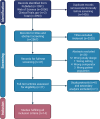Effectiveness of targeted post-acute interventions and follow-up services for sepsis survivors: a systematic review
- PMID: 40781720
- PMCID: PMC12333265
- DOI: 10.1186/s13054-025-05585-3
Effectiveness of targeted post-acute interventions and follow-up services for sepsis survivors: a systematic review
Abstract
Background: The majority of sepsis survivors suffer from significant long-term consequences, including cognitive, psychological, and physical impairments. Despite growing recognition of these challenges, there is a lack of robust evidence regarding effective post-acute interventions to improve long-term outcomes. This systematic review aims to compile the present evidence on the effectiveness of post-acute interventions and follow-up services on patient-relevant long-term outcomes of sepsis survivors.
Methods: PubMed, Web of Science and ClinicalTrials.gov were searched for relevant publications from 01/2013 until 08/2024. Studies evaluating the effect of targeted post-acute interventions and follow-up services compared to usual care were included. Risk of bias was assessed using the RoB2- and ROBINS-I tool.
Results: Fourteen studies including 383,680 patients from high-income-countries were identified. All included studies showed either a moderate risk of bias (non-randomized studies) or some concerns (randomized trials), primarily due to residual confounding, suboptimal blinding and outcome assessment. Interventions varied substantially in terms of measures, implementation time and outcomes addressed. Rehabilitation interventions were associated with long-term survival benefits until 10 years after sepsis according to three observational studies. Additionally, one randomized controlled trial with minimization found that an 8-week exercise-based intervention improved the anaerobic threshold in sepsis survivors. Interventions (n = 7) targeting care coordination and follow-up bundles led to reductions in rehospitalization rates and mortality until 12 months post-discharge and were associated with improvements in long-term physical function and PTSD symptoms. An ICU-specific virtual reality-based intervention may reduce symptoms of PTSD and depression up to six months after exposure.
Conclusion: Post-acute interventions, such as care coordination, bundle approaches, and rehabilitation can improve patient-relevant outcomes in sepsis survivors. However, the overall number of existing studies is small, all studies may be affected by certain forms of bias and for some domains of post-sepsis impairment no specific interventions have yet been identified. Therefore, further high-quality prospective follow-up studies are needed to strengthen the evidence regarding the effectiveness and acceptability of interventions across all domains of post-sepsis impairments, particularly cognitive impairments.
Keywords: Long-term outcomes of sepsis; Post-acute care; Post-sepsis syndrome; Sepsis; Sepsis sequelae.
© 2025. The Author(s).
Conflict of interest statement
Declarations. Ethics approval and consent to participate: Not applicable. Consent for publication: Not applicable. Competing interests: The authors declare no competing interests.
Figures


Similar articles
-
Exercise rehabilitation following intensive care unit discharge for recovery from critical illness.Cochrane Database Syst Rev. 2015 Jun 22;2015(6):CD008632. doi: 10.1002/14651858.CD008632.pub2. Cochrane Database Syst Rev. 2015. PMID: 26098746 Free PMC article.
-
Falls prevention interventions for community-dwelling older adults: systematic review and meta-analysis of benefits, harms, and patient values and preferences.Syst Rev. 2024 Nov 26;13(1):289. doi: 10.1186/s13643-024-02681-3. Syst Rev. 2024. PMID: 39593159 Free PMC article.
-
Psychological, social and welfare interventions for psychological health and well-being of torture survivors.Cochrane Database Syst Rev. 2014 Nov 11;2014(11):CD009317. doi: 10.1002/14651858.CD009317.pub2. Cochrane Database Syst Rev. 2014. PMID: 25386846 Free PMC article.
-
Non-pharmacological interventions for somatoform disorders and medically unexplained physical symptoms (MUPS) in adults.Cochrane Database Syst Rev. 2014 Nov 1;2014(11):CD011142. doi: 10.1002/14651858.CD011142.pub2. Cochrane Database Syst Rev. 2014. PMID: 25362239 Free PMC article.
-
[Volume and health outcomes: evidence from systematic reviews and from evaluation of Italian hospital data].Epidemiol Prev. 2013 Mar-Jun;37(2-3 Suppl 2):1-100. Epidemiol Prev. 2013. PMID: 23851286 Italian.
References
-
- Fleischmann-Struzek C, Born S, Kesselmeier M, Ely EW, Topfer K, Romeike H, Bauer M, Bercker S, Bodechtel U, Fiedler S, et al. Functional dependence following intensive care unit-treated sepsis: three-year follow-up results from the prospective Mid-German sepsis cohort (MSC). Lancet Reg Health Eur. 2024;46:101066. - PMC - PubMed
Publication types
MeSH terms
LinkOut - more resources
Full Text Sources
Medical

